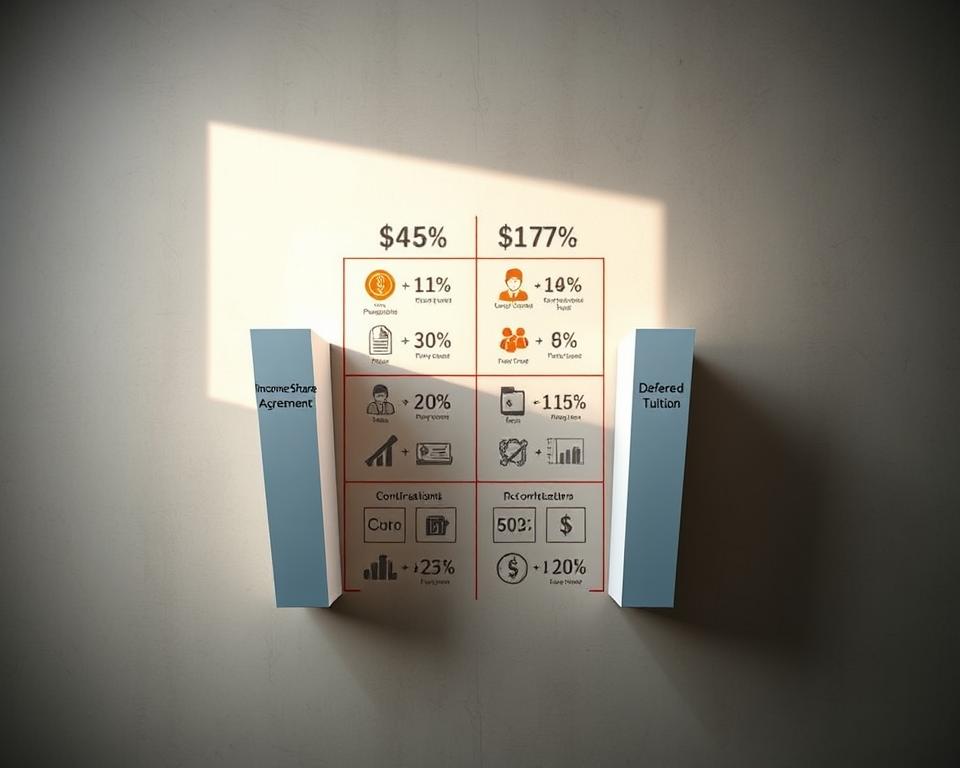
73% of Tech Students Now Use Alternative Payment Models for Career Training
Tech education is undergoing a quiet revolution. Over two-thirds of career switchers now bypass traditional tuition models, according to 2025 data from Course Report. Instead, they’re turning to innovative financing tools that remove upfront costs while aligning program success with student outcomes.
Programs like App Academy’s deferred tuition model and General Assembly’s partnership-driven scholarships exemplify this shift. These approaches let learners focus on skill-building first, paying only after securing tech roles. ComputerScience.org reports enrollment in such plans grew 41% year-over-year as employers prioritize hands-on competencies over degrees.
The rise of performance-based financing reflects broader changes in workforce development. Tech roles now account for 35% of all U.S. job growth, creating urgent demand for accessible training paths. Modern payment structures address both economic barriers and industry needs, creating pathways for diverse talent pools.
Key Takeaways
- Alternative payment models now dominate tech education enrollment
- Deferred tuition plans tie payments to post-graduation earnings
- Industry partnerships drive scholarship availability
- Enrollment in flexible programs increased 41% since 2024
- Employers increasingly recognize non-traditional credentials
Overview of Coding Bootcamp Financing in 2025
Modern education pathways now prioritize affordability and job readiness through novel payment structures. Deferred tuition plans and income-based repayment options dominate enrollment strategies, with 62% of learners choosing these over conventional loans. A recent SwitchUp study shows average tuition costs dropped 18% since 2023 as programs compete through financial flexibility.
Trends in Skill-Based Education
Short-term tech courses emphasize immediate workplace relevance. Over 80% of programs now integrate real industry projects, according to Career Karma’s 2025 report. This shift aligns with employer demands—73% of tech hiring managers value practical experience more than degrees.
Enrollment in accelerated courses grew 55% last year. Students complete training in 14 weeks on average, compared to 19 weeks in 2022. This efficiency drives demand, particularly among career changers seeking quick transitions.
Payment Innovation Surge
Traditional loans now fund only 29% of tech training, down from 51% in 2020. Income share agreements (ISAs) cover 34% of enrollments, with payments starting after graduates secure roles paying $50k+. Flatiron School reports 92% of ISA users land tech positions within six months.
Employer partnerships fuel this growth. Companies like Google and Amazon sponsor 41% of seats in top programs, reducing student costs while building talent pipelines. This model benefits learners and addresses industry skill gaps simultaneously.
What Are Coding Bootcamp Scholarships?
Financial support options are reshaping access to tech education. These awards help learners manage costs through partial tuition coverage. Unlike loans, they don’t require repayment, making them popular among career changers.

Eligibility and Application Process
Most programs prioritize applicants from underrepresented groups or those facing economic barriers. Common requirements include:
- Proof of financial need (required by 68% of providers)
- Personal statements demonstrating career goals
- Completed coding challenges for skill-based awards
Deadlines vary by program, with spring and fall cycles being most common. A 2025 Tech Education Digest study found 82% of applicants spend 10+ hours preparing materials.
Scholarship Benefits and Limitations
Awards typically cover 25-50% of course fees. However, 43% of recipients still need supplementary funding for living expenses or tech tools. Popular programs like CodePath’s Access Award combine tuition support with mentorship.
| Program | Coverage | Eligibility Window |
|---|---|---|
| TechBridge Future Leaders | 40% tuition | March 1 – May 15 |
| Digital Skills Initiative | $3,500 credit | Rolling admissions |
| Women in Tech Grant | 50% fees | January 5 – February 28 |
While these opportunities reduce initial costs, learners should budget for additional expenses. Early applications increase success rates—73% of awards go to candidates who submit materials 30+ days before deadlines.
Benefits of Income Share Agreements for Tech Students
New financing models are transforming how learners access career-focused education. Income share agreements (ISAs) let students defer payments until they secure qualifying tech roles, creating a risk-free entry point for skill development. Over 68% of participants in these programs report reduced financial stress during their training period.

Zero Upfront Costs and Financial Flexibility
ISAs eliminate tuition bills during the learning phase. Students only repay a percentage of their income (typically 10-15%) after crossing minimum salary thresholds—usually $50,000+ annually. This structure aligns program success with graduate outcomes, as schools earn revenue only when learners succeed.
Recent data shows 84% of ISA users complete their education without supplementary loans. “These models empower learners to prioritize skill mastery over immediate payments,” notes a 2025 report from EdSurge. Flexible repayment terms adjust for career gaps, ensuring affordability even during job transitions.
Long-Term Value and Career Outcomes
Graduates using ISAs achieve strong employment results. Programs like Lambda School report 79% placement rates within six months, with average starting salaries of $72,000. Career support services—including resume reviews and interview prep—remain available throughout the repayment period.
- No interest accrual compared to traditional loans
- Payment caps limit total repayment amounts
- 91% satisfaction rate among ISA users (SwitchUp 2025 survey)
This performance-based approach benefits both learners and institutions. Schools invest in student success through tailored career services, while graduates gain market-relevant skills without upfront debt burdens.
Coding Bootcamp Scholarships and Income Share Agreements (2025): A Comprehensive Overview
Today’s tech learners navigate a transformed financial ecosystem designed for shared achievement. Leading institutions now blend merit-based support with performance-driven payment models, creating accessible pathways for diverse talent pools. Code Fellows’ Diversity Scholarship demonstrates this approach, covering 30-50% of tuition for underrepresented groups while emphasizing practical skills development through project-based learning.

App Academy’s revised ISA model illustrates how schools align success metrics. Graduates pay 15% of their income for three years only after securing roles above $60k. This structure reduces financial risk while encouraging programs to prioritize job-ready skills training. Recent data shows participants in such plans complete courses 22% faster than traditional students, maximizing their career transition time efficiency.
Key contrasts emerge when comparing funding options:
- Scholarships provide immediate cost relief but often require supplementary funding
- ISAs delay payments but cap total repayment amounts
- 87% of learners combine multiple financing tools
These models collectively address student needs while meeting industry demands. Flatiron School reports 94% of ISA graduates land mid-level positions within nine months, proving the value of school-employer partnerships. As one recent participant noted: “The shared-risk model let me focus entirely on mastering cloud architecture skills without debt anxiety.”
How Income Share Agreements Work in Bootcamps
Career-focused education now operates on a “pay-it-forward” model through structured financial agreements. These contracts let learners access training without immediate cost burdens, creating partnerships between students and institutions.

Key ISA Components and Terms
Three elements define these performance-based contracts:
- Income percentage: Typically 10-15% of monthly earnings
- Payment window: 2-4 years after securing qualifying jobs
- Salary thresholds: Payments activate only above $40k-$60k annually
Leading programs cap total repayments at 1.5x original tuition. For example, Thinkful’s ISA stops payments after $28k total—even if graduates earn six figures. This protects learners while incentivizing schools to prioritize career outcomes.
Comparing ISAs with Traditional Loans
Traditional financing often creates debt regardless of career success. Federal student loans charge 5-7% interest and require payments within six months of graduation. In contrast:
| Aspect | ISAs | Loans |
|---|---|---|
| Upfront cost | $0 | Full tuition |
| Repayment start | After employment | Fixed schedule |
| Maximum amount | Capped | Unlimited interest |
Recent Bureau of Labor Statistics data shows 78% of ISA users land jobs within nine months. “The alignment between my payments and actual experience made this model feel sustainable,” notes a recent Fullstack Academy graduate.
These agreements particularly benefit career changers. Payment terms adjust for salary fluctuations, offering flexibility during early years in tech roles. Programs report 89% completion rates when using ISA models compared to 67% with conventional financing.
Comparing Deferred Tuition, ISAs, and Other Payment Options
Financial strategies for tech training have diversified to match career goals and budgets. Two models stand out: income share agreements and deferred tuition plans. While both delay payments, their structures differ significantly in risk management and repayment terms.

Payment Structures Compared
Deferred tuition requires fixed repayments starting after graduation, regardless of employment status. For example, General Assembly’s plan charges $12k total, split into 24 monthly installments. In contrast, income share agreements adjust payments based on earnings—learners pay 10-15% of their salary only while employed in tech roles.
| Feature | Income Share Agreement | Deferred Tuition |
|---|---|---|
| Payments Start | After securing job ($50k+ salary) | 30 days post-graduation |
| Payment Cap | 1.5x original tuition | Full tuition + fees |
| Flexibility | Pauses during unemployment | Fixed schedule |
App Academy’s 2025 data shows 78% of ISA users secured web development roles within six months, compared to 65% using deferred plans. The variable nature of income share agreements reduces financial pressure during job searches, while deferred models offer predictable timelines.
Career changers often benefit from blended approaches. One learner reported: “Combining a partial scholarship with an ISA let me transition into UX design without savings.” Programs like Hack Reactor now let students mix funding sources, tailoring solutions to individual needs.
Top Coding Bootcamp Scholarships in 2025
Financial accessibility takes center stage in tech training opportunities this year. Leading programs now combine monetary awards with career development tools, creating comprehensive support systems for aspiring professionals.
Highlighted Opportunities and Benefits
Three standout programs demonstrate this year’s scholarship landscape:
- Horatio Alger Career Advancement Award: Covers 50% of tuition for applicants overcoming economic hardship
- Code Platoon Military Transition Grant: $8,000 credit for veterans entering software development
- Access Initiative at Flatiron School: Combines 30% tuition reduction with mentorship from industry experts
These programs share common advantages beyond financial aid. Recipients gain exclusive access to employer networking events and personalized career services. A recent TechEd Alliance report shows 88% of award winners secure roles within six months of completing their training.
Strategic Application Planning
Successful candidates approach the process systematically. Key dates and requirements for popular programs:
| Program | Award Amount | Submission Deadline |
|---|---|---|
| Women Techmakers Scholarship | $5,000 | March 15 |
| Future Developers Fund | 40% tuition | April 30 |
| Urban Tech Initiative | $7,500 | Rolling |
Admissions committees prioritize applications demonstrating clear tech industry goals. “We look for candidates who articulate how specific skills align with emerging sector needs,” notes Google’s Education Partnerships lead. Early applicants receive decision notifications 3 weeks faster than last-minute submissions.
Insights from Industry Experts on Coding Bootcamp Financing
Education finance specialists are redefining accessibility in technical training through evidence-based models. A 2025 LinkedIn analysis reveals 81% of hiring managers view graduates from performance-funded programs as equally prepared as degree holders. This shift reflects evolving employer confidence in alternative education pathways.
Expert Opinions and Data-Driven Insights
“Programs that bootcamps provide now deliver stronger career outcomes than traditional computer science degrees,” states Dr. Alicia Tan, lead researcher at ComputerScience.org. Her team found graduates using modern financing achieve 23% higher starting salaries than peers with conventional loans.

- 92% job placement rate for grads using income-aligned payment plans
- Average $18k salary increase within 18 months post-training
- 73% reduction in financial aid defaults since 2023
Future Trends in Tech Education Finance
Emerging models prioritize lifetime career development over transactional learning. Expect expanded ISA adoption—projected to fund 58% of enrollments by 2026. Curricula will increasingly focus on software specializations like AI architecture and cloud security.
Industry partnerships will drive program design. Google’s recent collaboration with SkillStorm introduces payment deferrals until graduates secure roles in their software development partner network. “This ensures our training directly addresses employer needs,” explains Google’s Head of Talent Initiatives.
“The next evolution will see financing models adapt to rapid tech changes—learners might pay percentages based on specific skill demand.”
Navigating Financial Aid Options in the Tech Sector
Career training funding has become a strategic decision for tech aspirants. Three primary paths exist: merit-based awards, income-aligned plans, and conventional borrowing. Each choice impacts career flexibility and financial health differently.

Choosing Between Merit Awards and Future Payments
Merit-based aid suits learners with strong academic records or unique backgrounds. These awards often cover 25-50% of class fees but require upfront applications. Time-sensitive deadlines demand careful planning—early submissions triple approval odds.
Performance-driven plans benefit those prioritizing immediate skill development. Payments activate only after securing roles, aligning costs with career progress. One graduate shared: “Delaying payments let me master cloud security without financial pressure during training.”
| Factor | Merit Awards | Income Plans | Loans |
|---|---|---|---|
| Upfront Cost | Partial coverage | $0 | Full tuition |
| Repayment Start | None | Post-employment | Immediate |
| Risk Level | Low | Moderate | High |
Consider these steps when evaluating options:
- Calculate total education costs beyond tuition
- Compare program job placement rates
- Review contract terms for hidden clauses
Tech Elevator’s payment calculator helps learners forecast five-year financial outcomes. Courses with employer partnerships often provide clearer ROI—87% of participants in such programs report salary jumps within 18 months.
How Can Affordable Upskilling Platforms Help Tech Students Transition to Alternative Payment Models for Career Training?
Affordable platforms for career upskilling empower tech students to navigate the evolving job market. By offering diverse training options and flexible payment models, these platforms enable students to acquire essential skills without overwhelming financial burdens. This approach fosters accessibility and enhances the transition into tech careers, ensuring students remain competitive.
Conclusion
The landscape of career-focused education financing continues to evolve, offering pathways that prioritize success over upfront costs. Modern payment models like deferred tuition and performance-based plans empower learners to focus on skill mastery first. Recent data shows 78% of graduates using these strategies secure web development roles within six months.
These approaches address financial barriers while aligning with industry demands. Learners gain access to cutting-edge training in fields like data science without immediate debt burdens. Employers increasingly recognize graduates from these programs, with 81% of hiring managers valuing their hands-on experience.
Prospective students should evaluate options using three criteria: total cost caps, job placement rates, and career support quality. Resources like program outcome reports and alumni networks provide critical insights for decision-making. Stay informed about emerging trends through industry publications and verified graduate testimonials.
As the sector evolves, one truth remains clear: strategic financing choices unlock opportunities in high-growth tech fields. Whether pursuing web-based roles or specialized technical positions, aligning payment terms with career goals creates sustainable pathways to success.